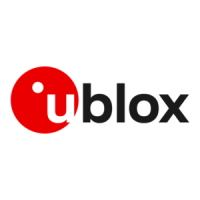SARA-R42 - Application note
UBX-20050829 - R02 Cellular technology overview Page 7 of 58
C1-Public
2 Cellular technology overview
SARA-R42 modules support LTE Cat M1 and NB-IoT as LPWAN technologies plus the 2G RAT as
fallback, such as used in application areas:
• Automotive and transportation
• Smart metering
• Smart cities
• Smart buildings
• Connected health
• Agricultural and environmental
2.1 Radio Access Technologies (RATs)
2.1.1 LTE Cat M1
LTE Cat M1 is a low‑power wide‑area (LPWA) air interface that enables the connection to IoT and
M2M devices with medium data rate requirements. It increases battery lifespans thanks to enhanced
power saving mode and extended in‑building range (up to 15 dBm more than LTE, thanks to the
repetitions of transmissions provided in the Coverage Enhancement modes), as compared to
standard cellular technologies such as 2G, 3G, or LTE Cat 1.
LTE Cat M1 is defined by the 3GPP Release 13 and is a LPWA technology operating in the licensed
spectrum. Operating in half duplex mode with typical speeds of 375 kbit/s, which can reach 1 Mbit/s
on some networks thanks to protocol stack enhancements, LTE Cat M1 specifically supports IoT
applications with low to medium data rate needs. At these speeds, LTE Cat M1 can deliver remote
firmware updates over‑the‑air (uFOTA, with access to MNOs and u-blox servers via the LwM2M
protocol) within reasonable timeframes, making it well‑suited for critical applications running on
devices that may be deployed in the field for extended periods of time.
As M stands for mobility, the LTE Cat M1 standard specifies Connected Mode Mobility, which the
module supports through inter-frequency and intra-frequency handover capability, resulting in higher
reliability of transmissions, particularly important in non-static usage.
2.1.2 NB-IoT
Narrowband IoT (NB‑IoT Internet of Things) is a Low Power Wide Area (LPWA) technology
standardized by 3GPP release 13 as a specialization of the LTE standard, operating with 200 kHz
bandwidth which allows it to work virtually anywhere. Since it operates in licensed spectrum, it is
secure and reliable, providing guaranteed quality of service.
NB-IoT is optimized for applications that need to communicate small amounts of data over long
periods of time. Similar to Cat M1, it offers very low power consumption and excellent extended
coverage in buildings and underground. Battery life of up to 10 years on a single charge in some use
cases also contributes to lower maintenance costs for deployed devices, even in locations where end
devices may not be connected directly to the power grid.
SARA-R4 series modules support both CP (Control Plane) and UP (User Plane) Cellular IoT EPS
optimizations, Cat-NB2 (3GPP Release 14 upgraded version of the NB-IoT standard, which increases
the maximum bit rate from ca 30-60 kbit/s to up to 120-160 kbit/s), NAS and AS (Access Stratum)
RAI (Release Assistance Indicator) for faster release of the RRC connection at the end of the data
transactions.

